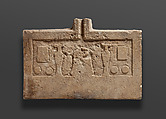Offering table
Middle Kingdom
Discovered at Lisht North, this offering table was originally dated by the excavators to the Ramesside Period, but comes instead from the mid-12th Dynasty. The upper surface is carved with an inset panel framed at the bottom by the hieroglyph for offerings, hetep, which echoes the shape of a mat on which offerings of food and drink would have been placed in earlier tombs. Within the panel, which opens into a shallow spout on one of the long sides, are images of ritual vessels and foodstuffs. The rectangles, which are unusal features, may represent clusters of long conical bread loaves arranged in alternating directions to form quadrilaterals. Such details might have been rendered by zigzag lines drawn over the rectangles in ink that has since faded away. The absence of inscriptions might indicate that the text was added only in ink.
This offering table originally would have been placed in a tomb chapel; water poured over it would have served to activate the purification rituals and food offerings in order to nourish the spirit of the deceased. It would also have served as a magical substitute to provide eternal sustenance for the tomb owner in the event that his or her actual cult ceased to be carried out.
This image cannot be enlarged, viewed at full screen, or downloaded.

